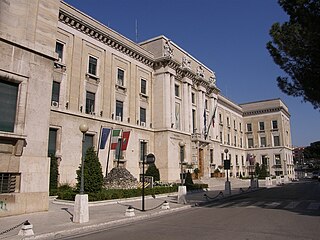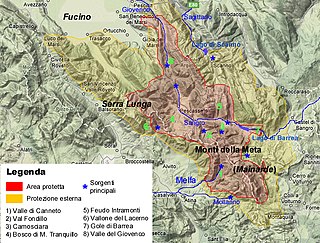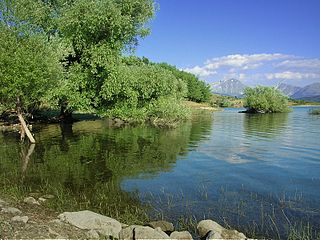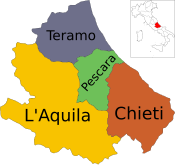
Abruzzo is a region of Southern Italy with an area of 10,763 square km and a population of 1.3 million. It is divided into four provinces: L'Aquila, Teramo, Pescara, and Chieti. Its western border lies 80 km (50 mi) east of Rome. Abruzzo borders the region of Marche to the north, Lazio to the west and north-west, Molise to the south and the Adriatic Sea to the east. Geographically, Abruzzo is divided into a mountainous area in the west, which includes the highest massifs of the Apennines, such as the Gran Sasso d'Italia and the Maiella, and a coastal area in the east with beaches on the Adriatic Sea.

Pescara is the capital city of the Province of Pescara, in the Abruzzo region of Italy. It is the most populated city in Abruzzo, with 119,217 (2018) residents. Located on the Adriatic coast at the mouth of the Aterno-Pescara River, the present-day municipality was formed in 1927 joining the municipalities of the old Pescara fortress, the part of the city to the south of the river, and Castellamare Adriatico, the part of the city to the north of the river. The surrounding area was formed into the province of Pescara.

Gissi is a town and comune located in the Province of Chieti, Abruzzo, Italy.

The province of Chieti is a province in the Abruzzo region of Italy. Its provincial capital is the city Chieti, which has a population of 50,770 inhabitants. The province has a total population of 387,649 inhabitants as of 2017 and spans an area of 2,599.58 square kilometres (1,003.70 sq mi). It is divided into 104 comuni (comune) and the provincial president is Mario Pupillo.

The province of Pescara is a province in the Abruzzo region of Italy. Its provincial capital is the city Pescara, which has a population of 119,483 inhabitants. As of 2017, it has a total population of 319,936 inhabitants over an area of 1,230.33 square kilometres (475.03 sq mi). The provincial president is Antonio Zaffiri and the province contains 46 comuni.

Avezzano is a city and comune with a population of 40,712 inhabitants, situated in the Abruzzo region, province of L'Aquila, Italy. It is the second most populous municipality in the province and the sixth in the region. Avezzano was documented as an existing urban center in the ninth century. The city was destroyed by the earthquake of 1915. It was rebuilt after the 1944 Allied bombing. The city was decorated with the silver medal for civil merit, an award granted by the Italian Republic.

Abruzzo, Lazio and Molise National Park is an Italian national park established in 1923. The majority of the park is located in the Abruzzo region, with smaller parts in Lazio and Molise. It is sometimes called by its former name Abruzzo National Park. The park headquarters are in Pescasseroli in the Province of L'Aquila. The park's area is 496.80 km2 (191.82 sq mi).

Pescasseroli is a town and comune in the province of L'Aquila, in Southern Abruzzo, central Italy.

D'Annunzio University is a public research university located in Chieti and Pescara, neighbouring cities in the region of Abruzzo, Italy. Established in 1960 as a higher education institute and named after writer and poet Gabriele D'Annunzio, it was officially recognised as an independent university in 1965 by Minister Luigi Gui.

Abruzzo Airport is an international airport serving Pescara, Italy. It is located approximately 4 km from the centre of Pescara, about 180 km from Rome, a 2-hour drive by car on a motorway across the Apennine mountains. The airport is located on the state road 5 Via Tiburtina Valeria and is well connected to important road and railway connections.

Penne is an Italian town in the province of Pescara, in the Abruzzo region, in mid-southern Italy. According to the last census in 2014 the population was 12,451. In 2012 Penne was selected as one of the "Most Beautiful Towns of Italy"

Francavilla al Mare is a comune and town in the province of Chieti, in the Abruzzo region of Italy.

Montepulciano d'Abruzzo is an Italian red wine made from the Montepulciano wine grape in the Abruzzo region of east-central Italy. It should not be confused with Vino Nobile di Montepulciano, a Tuscan wine made from Sangiovese and other grapes.

Abruzzo is an Italian wine region located in the mountainous central Italian region of Abruzzo along the Adriatic Sea. It is bordered by the Molise wine region to the south, Marche to the north and Lazio to the west. Abruzzo's rugged terrain, 65% of which is mountainous, help to isolate the region from the winemaking influence of the ancient Romans and Etruscans in Tuscany but the area has had a long history of wine production.

Tourism in Abruzzo has become one of the most prosperous sectors in the economy of Abruzzo, and in recent years has seen a remarkable growth attracting numerous tourists from Italy and Europe. According to statistics from the Italian institute of statistics (ISTAT), in 2007 arrivals totaled 1,371,155 Italians and 189,651 foreigners. A total of 7,374,646 arrivals were tourists, a figure that puts the region seventeenth among the Italian regions for numbers of tourists per year. According to market analysis and sector studies on tourism in the Abruzzo National Society TurisMonitor 2012, after an increase that was estimated at between 4 and 5% of international tourist arrivals in the Abruzzo region in 2012 was estimated to increase that international arrivals will be around 3/4% by the end of 2012 with staff working in tourism will increase settling at about 25,000 people. Always position first-arrivals from Germany. A moderate support to tourism is also given to the Abruzzo Airport with many low cost and charter flights connecting the entire region with the rest of Europe.

Castello Caldoresco is a Renaissance castle in Vasto, Province of Chieti, Abruzzo, south-eastern Italy. It is a private property and therefore is not open to the public.

Avezzano concentration camp was an Italian assembly and detention camp set up in 1916 in the Abruzzo city of the same name during World War I, immediately after the 1915 Marsica earthquake that almost completely destroyed it decimating the population. The detention camp was reserved to about 15,000 prisoners from the Austro-Hungarian army, mainly of Czech–Slovak, Polish, German, and Hungarian nationalities; Romanians, who were gathered in the Romanian Legion of Italy by the end of the conflict, had a garrison and a training camp in Avezzano. Mostly abandoned in 1920, a sector was reused in World War II to house Indian, English, New Zealand, and Pakistani war prisoners.

Monte Salviano is a massif in the Abruzzo Apennines, Central Italy. It includes the peaks of Monte d'Aria, Monte Cimarani and Monte San Felice. Since 1999 the area, falling within the municipal territory of Avezzano, has been included in the Riserva Naturale di Monte Salviano.

The Riserva Naturale di Monte Salviano or Riserva naturale guidata Monte Salviano is a nature reserve in Abruzzo, Italy, established in 1999. It lies in the territory of the comune (municipality) of Avezzano, in the Province of L'Aquila. The reserve is named after Monte Salviano, a massif that extends northwest to southwest dividing the Fucine basin from the Palentine Plains, in the Marsica sub-region.

Over the years, Abruzzo has managed to become the most industrialized region of southern Italy and has had significant improvements and growth also at an economic level; the region has reached and surpassed many Italian regions in the specialization of the various industrial sectors and today it is the richest of the regions of Southern Italy.





















